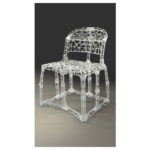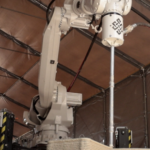A notable portion of production 3D printing is dedicated to supplying replacement parts, and I say replacement parts rather than spare parts because these are being printed on-demand. That’s an important distinction when storage accounts for so much cost and space in all spare parts supply chains. But physical inventory reduction isn’t the only reason that companies and organizations around the world are adopting 3D printing to provide on-demand replacement parts. Here are some of the other reasons:
- Shorter lead times – By printing a part in a manufacturing hub that’s near the customer, nearly all of the time associated with shipping and logistics is eliminated, so that part makes it into their hands much sooner. In critical applications, a week or two difference in time is significant.
- Cost savings – A 3D printed part might cost more than a machined or injection molded part, but after factoring in the reduced freight and storage costs as well as the cost savings attributed to the reduction of downtime due to getting the part sooner, it’s often the case that 3D printing is the more economic option.
- Recontinued parts – Eventually, every part gets discontinued, either to being made obsolete to a newer iteration or because the manufacturer shuts down. For customers still using machinery that runs on those discontinued parts, well, they’re in a pickle. On-demand 3D printing can resurrect discontinued parts and extend the life of legacy equipment.
- Larger inventories – One of the hardest aspects of managing physical inventory is predicting which parts will be needed and how many of each to keep in stock. Parts don’t always fail in their expected lifetime, and even if they did, keeping track of the age of every part of every customer is still quite a task. When a supplier miscalculates demand, they either end up with excess inventory, which incurs extra costs to them, or they don’t have enough parts to meet the needs of their customers, which incurs extra costs to them and the customers. The digital inventories of on-demand 3D printing allow suppliers to meet the unpredictable needs of their customers without all the storage costs.
- Customization – Similarly, 3D printed parts can be offered in different colors, textures, and materials. They can also be easily personalized and branded. Again, these features don’t cost extra.
- Increased performance – Long gone are the days of flimsy 3D printed plastic prototypes. Today, 3D printed metals are harder than forged metals and several other 3D printing technologies provide isotropic parts on par with parts produced through conventional manufacturing.
Early Adopters
From national militaries to international companies, the list of companies using AM to supply their customers with replacement parts is ever growing. Deutsche Bahn, a German railway company, uses 3D printing to extend the life of its trains by 3D printing parts that have been discontinued. The French military increases their readiness by 3D printing replacement parts in the field. Bentley 3D printed parts to recreate a 1929 Blowers model car, and other automotive companies are using 3D printing to help their customers maintain their older cars as well. CNH Industrial reduces the downtime of their customers’ transportation and agricultural equipment by 3D printing replacement parts on-demand.
US Military Modernizes its Manufacturing with AM
The US military is no stranger to 3D printing as they’ve employed several AM technologies across a variety of applications, such as the Army converting plastic bottles into 3D printed radio brackets, the Navy developing 3D printed smart parts with embedded sensors, and the Army building the world’s largest metal 3D printer. Now, the Army is expanding its use of AM to more efficiently supply replacement parts to soldiers. Four-star General Gus Perna, head of Army Materiel Command, is leading the initiative.
I want machines out there that can fix what we call readiness drivers. Things that break down a lot so that they can be done forward. General Gus Perna
One of the goals of the plan is to make an advanced manufacturing hub out of the Advanced Manufacturing Center of Excellence at Rock Island Arsenal, Illinois. Some $25 million has been spent on equipment for the hub, which currently fills only about a quarter of the warehouse there, and Perna wants it at full capacity. A couple dozen depots, arsenals, and plants will be selected to operate with the hub to maximize its reach and effectiveness.
Perna doesn’t want to cause unnecessary headaches by replacing current supply chains but wants 3D printing to help carry the load, saying “I don’t want to take it over. I don’t want to replicate it. I want to be able to influence and react to the readiness drivers that are needed on the battlefield in a timely manner. So if a ship goes down or something, I want to be able to replicate that capability and make the requirement occur.” Right now he’s focusing on developing the digital communication and database systems that will link the hub to the other sites and divisions.
Limited testing of 3D printing at the tactical level is ongoing at the 25th Infantry Division in the Pacific and the 2nd Infantry Division in South Korea. Perna expects that feedback from their personnel will guide the overall initiative.
AM for Marine Replacement Parts
The marine equipment and spare parts procurement website ShipParts.com recently announced that they’ll be adopting 3D printing to supply parts to customers more quickly. Reducing downtime in the marine industry where ships wind up stranded hundreds of miles from shore is literally a matter of life and death. “Currently, logistics become involved, and that takes time. If our manufacturers have to send a part, say from an origin factory, where it is made, to the destination port or shipyard where the customer needs it, then there are costs involved. If we just send the secure data to a 3D manufacturing hub at the port or shipyard, where the data can be verified and the part produced, the customer can receive the parts within a much shorter lead time,” said Roy Yap, Shipparts.com Chief Growth Officer.
Yap explains that even though it’s known that some parts are consistently in demand, like pump impellers, it’s difficult to predict which styles and sizes will be needed at any given time, stating, “We have over five years of data, so we know which parts are fast moving. Pump impellers readily lend themselves to 3D printing.”
ShipParts.com works with more than 1,800 clients and 17,000 sellers across the globe so their adoption of AM will have far-reaching benefits. The reduced emissions alone are worth the restructuring costs. They don’t currently plan to do any of the 3D printing in-house; they’ll be partnering with established printing services to build a dependable network that can produce replacement parts on-demand.
It’s hard to argue with the sales pitch of producing replacement parts with 3D printing: make the exact part the user needs, when they need it, where they need it. It makes sense that we see an increasing rate of adoption as it enables suppliers to run leaner and greener.











